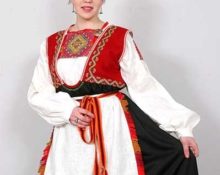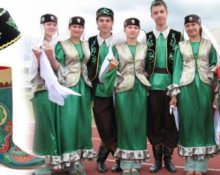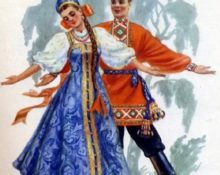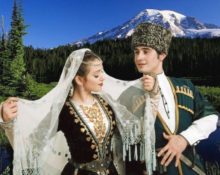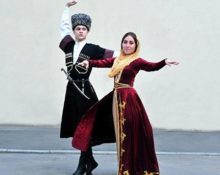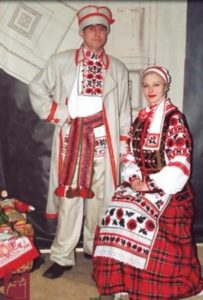 A traditional national costume is usually called a well-established set of certain wardrobe elements, shoes and various jewelry. Such the outfit was compiled over several centuries and was directly dependent on the specific climatic conditions and folk customs.
A traditional national costume is usually called a well-established set of certain wardrobe elements, shoes and various jewelry. Such the outfit was compiled over several centuries and was directly dependent on the specific climatic conditions and folk customs.
History of Belarusian costume
The initial mention of the traditional clothing of Belarusians is found in the Statute of the Grand Duchy of Lithuania in 1588. Information about clothing and its images can also be seen in the travel notes of travelers who visited the principality.
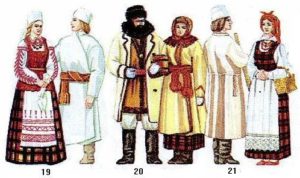 The traditions of the people have undergone changes over time, and along with this, the appearance of the national Belarusian attire has also changed.
The traditions of the people have undergone changes over time, and along with this, the appearance of the national Belarusian attire has also changed.
By the end of the 19th and beginning of the 20th centuries, ethnic characteristics began to be clearly visible in these clothes. The patterned compositions used for decoration contained elements of ancient paganism, and the influence of urban culture was also noticeable.
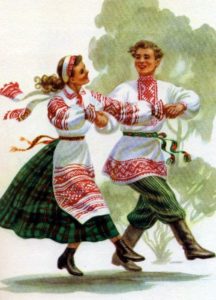 The traditional features of this costume are the antique multi-type ornament and striped decor. In different regions of the country, national costumes had certain differences. In total there were about 22 varieties.
The traditional features of this costume are the antique multi-type ornament and striped decor. In different regions of the country, national costumes had certain differences. In total there were about 22 varieties.
Peculiarities
Despite the fact that the national Belarusian outfit has many similarities with Russian and Ukrainian traditional costumes, it nevertheless stands out for its originality and is considered an independent phenomenon. One of its characteristic features is the rational combination of practicality and decorativeness.
The national outfit of Belarusians was made from fabrics made from local materials of organic origin.
 The main shades used in clothing of this kind were white, red, blue and green. White was the dominant color. A characteristic distinctive feature of the Belarusian national costume was rich embroidery, initially with a predominance of geometric elements, and some time later - floral ones.
The main shades used in clothing of this kind were white, red, blue and green. White was the dominant color. A characteristic distinctive feature of the Belarusian national costume was rich embroidery, initially with a predominance of geometric elements, and some time later - floral ones.
Reference! The elements of the ornamental pattern on various parts of clothing together made up a complete composition.
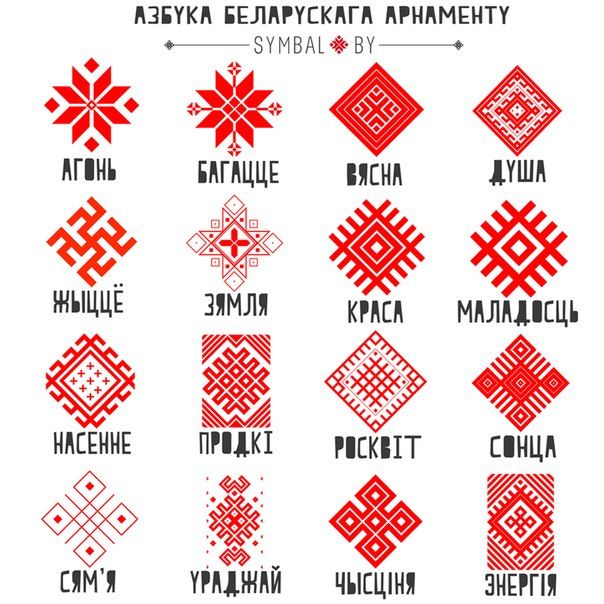 When creating such a costume, in addition to direct weaving, weaving, leather processing and other types of decorative and applied arts were also used.
When creating such a costume, in addition to direct weaving, weaving, leather processing and other types of decorative and applied arts were also used.
Types of suits
Male
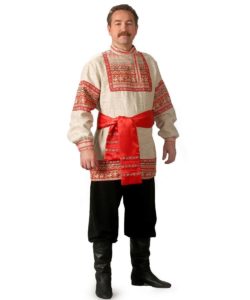 The male version of the national attire of the Belarusians consisted of an untucked linen shirt, trousers (legs), a belt, a vest made of cloth (camisel) and a headdress. The shirt had a turn-down collar and a slit on the chest; the collar and lower part were decorated with embroidery. Men usually girded themselves with a bright belt.
The male version of the national attire of the Belarusians consisted of an untucked linen shirt, trousers (legs), a belt, a vest made of cloth (camisel) and a headdress. The shirt had a turn-down collar and a slit on the chest; the collar and lower part were decorated with embroidery. Men usually girded themselves with a bright belt.
The trousers could be without a belt (sometimes they were tied with a string). There were also models with a belt, fastened with a button.
Female
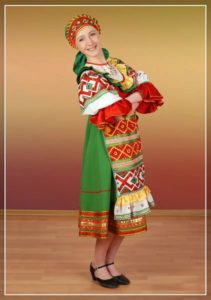 Shirts (kashuli) for women were made from linen. They were long and always had embroidered patterns. Skirts (spadnitsy), which were worn over shirts, were made from different fabrics.
Shirts (kashuli) for women were made from linen. They were long and always had embroidered patterns. Skirts (spadnitsy), which were worn over shirts, were made from different fabrics.
Summer versions (“letniki”) were made of linen, homespun winter ones (“andaraki”) were made from cloth, and individual items for adult women (those who had already gotten married and those just getting engaged) were made from ponyev. An embroidered apron was worn over the skirt, matching the color and pattern of the shirt. A short vest (garset) was worn over the shirt.
Reference! The poneva skirt was made from three pieces of material, gathered at the top with a cord and tightened at the waist. There was a closed and swing version of this type of clothing. In a closed one, all the pieces of fabric were sewn together, and if there were open pieces in front and on the sides, it was a swing blanket. In almost all cases, the poneva was decorated with beautiful ornaments.
An important detail of such a costume was also the belt. There were fabric, knitted and wicker versions of this product, with fringe, tassels and pom-poms. The belt was always decorated with colored patterns. For this, a combination of green, white and red colors was most often used.
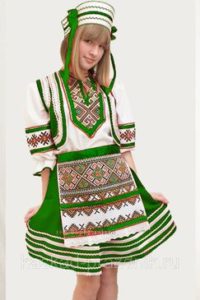 Outerwear for women was practically no different in cut from men's, but at the same time it was distinguished by richer embroidery and appliqué.
Outerwear for women was practically no different in cut from men's, but at the same time it was distinguished by richer embroidery and appliqué.
Reference! Both women's and men's models of national clothing did not have pockets. Instead, they made do with a leather handbag, which was attached to a belt or thrown over the shoulder.
Children's
Similar outfits for boys and girls were almost indistinguishable from the costumes of adults. Children under the age of 6-7 years, regardless of their gender, wore an ordinary linen shirt that reached to the heels and was tied at the waist with a belt.
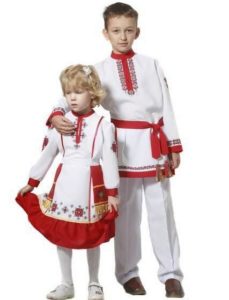 Boys at the age of 7-8 put on their first pants, and girls at the same age began to put on their first skirts. Other components of the costume were added as the child grew older.
Boys at the age of 7-8 put on their first pants, and girls at the same age began to put on their first skirts. Other components of the costume were added as the child grew older.
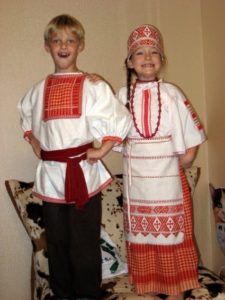 The girls had to sew and embroider their first apron themselves.
The girls had to sew and embroider their first apron themselves.
Hats
As a headdress in the summer, men used a bril (a straw headdress with a voluminous brim), and in the winter, a hat made of fur (ablavukha). Homemade sheepskin of grey, brown or black was also used to make hats.
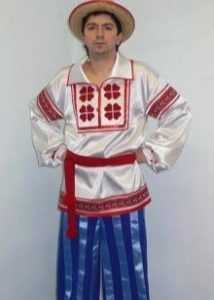 In the second half of the 19th century, the cap became widespread (summer version of the hat with a hard varnished visor).
In the second half of the 19th century, the cap became widespread (summer version of the hat with a hard varnished visor).
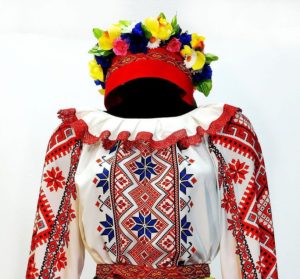 As shoes for every day, men used bast shoes (bast, hemp or wicker) in the summer, postols (raw leather sandals) in the spring and autumn, and felt boots lined with leather or felt fabric in the winter.
As shoes for every day, men used bast shoes (bast, hemp or wicker) in the summer, postols (raw leather sandals) in the spring and autumn, and felt boots lined with leather or felt fabric in the winter.
Shoes and accessories
Women wore bast shoes as footwear in summer and felt boots in winter. On holidays, such shoes were replaced by charaviks (leather shoes) or boots. In all cases, a headdress was put on the head, by which it was easy to recognize the marital status of its owner.
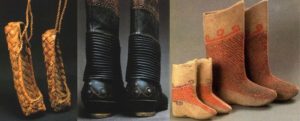 Before marriage, girls used wreaths and narrow towel headbands for this purpose. Married ladies replaced these headdresses with a wedding shawl. Ribbons, glass beads, temples, and other options were usually used as decorations.
Before marriage, girls used wreaths and narrow towel headbands for this purpose. Married ladies replaced these headdresses with a wedding shawl. Ribbons, glass beads, temples, and other options were usually used as decorations.
Fabric selection
To make the traditional outfit of Belarusians, exclusively materials of natural origin were used. The base fabric most often used for this purpose was linen.
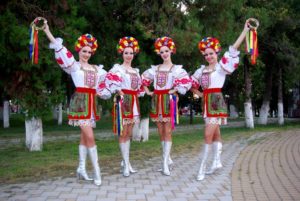 Initially, wool and fabric made from hemp fibers were also used in the manufacture of such clothing.Outerwear was made mainly from sheepskin and thick cloth.
Initially, wool and fabric made from hemp fibers were also used in the manufacture of such clothing.Outerwear was made mainly from sheepskin and thick cloth.
Modern images
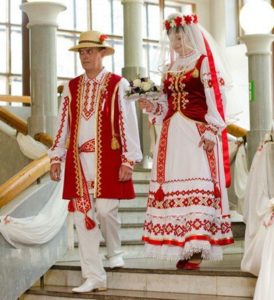
Modern Belarusian wedding suits
Elements of the national Belarusian outfit can be successfully used to create stylish modern images of Belarus (formerly Belarus).
Here are some successful examples (photos):
- To create an ethno-casual look, you can use a shirt decorated with bright national embroidery, which will look harmonious with a skirt or jeans.
- Decorated with rich traditional embroidery in the Belarusian style, the dress will allow any representative of the fair sex to be the center of attention.
- A white T-shirt decorated with a national ornament will suit both a girl and a young man equally well.
- Children's clothing, decorated with bright traditional patterns, looks original and attractive.
The national costume is considered to be the embodiment of the concept of the ideal image of a representative of a certain nation. Over the long path of historical development, traditional Belarusian attire has managed to preserve the characteristics of manufacturing technologies and fabrics used, as well as cut, methods of decoration and wearing options that are characteristic of all Slavs.


 2
2